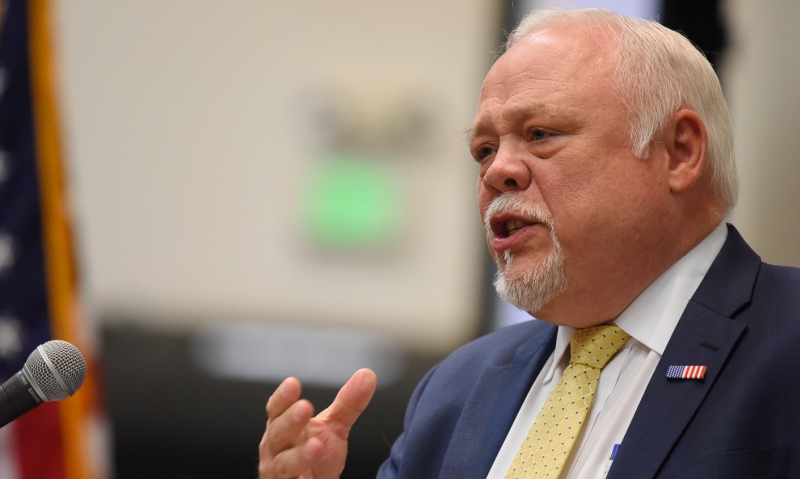
Legionnaires learn about preparedness, awareness at national security meeting
More than 300 Legionnaires packed the meeting room during The American Legion's National Security Commission meeting and POW/MIA update Aug. 19, at the Reno-Sparks Convention Center in Reno, Nev.
Presentations for the commission meeting during the Legion’s 99th National Convention were provided to the members by the American Red Cross of Nevada, U.S. Selective Service System, Defense POW/MIA Accounting Agency and the National League of POW/MIA Families. The key theme was preparedness and awareness.
“We all have the opportunity for a natural disaster to strike … you need to be prepared in the event of a disaster,” said American Red Cross of Nevada Executive Director Zanny Marsh. “We respond to about 70,000 disasters and the frequency of large scale disasters may be increasing, but the most common disaster that we respond to are home fires.
“In our local community, Red Cross volunteers are responding to a home fire about every 41 hours, but in Las Vegas it’s every 15. By educating yourself about preparedness, you can reduce the risk of devastation, injury or death for your spouse, your family, or your neighbors.”
Marsh recommends a practice called “Be Red Cross Ready.” These steps include:
1. Get a kit
2. Make a plan
3. Be informed
Detailed information on how to prepare for emergencies can be found at the American Red Cross website.
“The time is now – your partnership is essential,” Marsh concluded. “I hope that when you return home, you contact your local chapters and ask them how you can further implement the strategies to ‘Be Red Cross Ready.’”
Legionnaires also learned how America is prepared on the home front. Despite the success of an all-volunteer military force, registration with Selective Service must continue as a key component of national security strategy.
The Selective Service System prepares our nation with a structure and a system of guidelines which will provide the most prompt, efficient, and equitable draft possible, if the country should need it.
“We are a necessary and incredibly inexpensive insurance policy that ensures the availability of trained and untrained personnel to the Department of Defense in the event of a national emergency,” said Donald Benton, director of the Selective Service System. “Like The American legion, we must be maintained and maintained with an appropriate budget.”
The Selective Service System’s mission is to provide manpower to the armed forces in an emergency; and to run an Alternative Service Program for men classified as conscientious objectors during a draft.
“It’s extremely important to realize that the registration of the Selective Service (for men aged 18-25) is the law, but compliance with the law comes with certain tangible benefits and failure to register has consequences,” he said. “Registration is linked, by congressional acts, to important education, job training, and employment benefits at both the federal and state level.”
It takes 45 seconds to register at www.sss.gov, according to Benton as he urged the committee to spread the word.
“Many of the young men in our communities, in your communities, are losing these benefits because they have not registered,” he continued. “My fear is that the many young men that don’t register don’t even realize that they are losing these opportunities until it’s too late.”
As of today, the Selective Service continues to register only men, but Benton also addressed if women were going to be required to register.
“Women have proudly and honorably served our volunteer force,” he said. “We do not create policy. We implement policy that the president and the Congress direct, and we have not been directed to register women.”
Benton praised the men and women currently serving in the 130 countries around the world. He concluded by saying, “We stand behind and ready to back up our all-volunteer military force.”
In the unfortunate event a servicemember is missing following a war or conflict, it’s the responsibility of the Defense POW/MIA Accounting Agency (DPAA) to recover those personnel.
Legionnaires received an update from Johnie Webb, the deputy director for External Relations and Legislative Affairs for DPAA.
“We had to develop a new technique, a new tool, that will allow us to identify individuals and that tool is the chest x-ray comparison,” Webb said. “We were able to find the chest x-rays of many of the individuals from World War II and Korea that were still in the archives.”
X-rays were restored and digitized, then used to identify the remains of individuals. According to Webb, the Armed Forces Medical Examiner approved this technique as an official means of identification earlier this summer. He said that there are more than 83,000 Americans still missing, many of them deep sea losses, requiring additional assistance. Because of this, Congress has allowed DPAA to partner with universities, underwater archology experts, and other private groups to assist with the identification and recovery efforts.
More information on accounting for missing personnel can be found at the DPAA website.
The American Legion National Commander Charles E. Schmidt made a surprise visit to the National Security Commission meeting and noted the importance of national security and POW/MIA recovery efforts.
“It’s our responsibility, our legacy, that we’ve inherited to pay attention to the national security of our great country,”Schmidt said. “Our resolution says we call for a full accounting until they all come home.”
